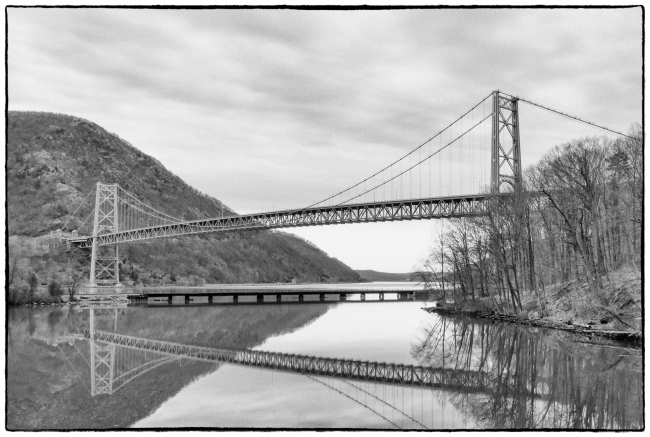As mentioned in earlier posts the pontoon bridge that crossed Popolopen Creek during the Revolutionary war was eventually (and much much later) replaced by a permanent structure. According to Wikipedia:
The red-blazed Popolopen Gorge Trail runs along the south side of the creek to a foot bridge just south of Popolopen Torne. Here, it joins the blue-blazed Timp-Torne, 1777 West and 1779 trails. These run along the north side of the creek from Hell Hole to the bridge, with the Timp-Torne detouring over the summit of Popolopen Torne. They cross the footbridge and join the Popolopen Gorge Trail to detour around West Point property, and the combined trails turn southwest and follow the valley of Queensboro Brook.
On October 6, 2002, New York Governor George Pataki dedicated a long suspension foot bridge which spans the creek a short distance further downstream. The novel design embracing a stiffened Suspended Rope Truss Bridge was proposed by Bruce Ramsay & Jim Hume of Cleveland Bridge Ltd. The final design & construction was carried out by Cleveland Bridge Ltd. The foot bridge connects the Twin Forts Trail to its intersection with the Appalachian Trail on the western side of the Bear Mountain Bridge.
…
As noted above a new footbridge (built 2002) has been constructed across the Popolopen Creek just downstream from this bridge. The concept design of this bridge was proposed by Bruce Ramsay & Jim Hume of Cleveland Bridge Pty. Ltd. of the U.K., Cleveland Bridge were also responsible for its construction. The footbridge was designed as a suspended rope truss, which results in a very stiff bridge due to its diagonal braces. Another special feature is the fiber composite deck in lieu of a traditional timber deck for this type of structure. The fiber composite deck adds lightness, long term durability and reduced maintenance requirements.
According to the Dorman Long Technology (the US arm of Cleveland Bridge) site:
Completed in 2002, the Popolopen Creek Footbridge was designed by DLT to create an economic and aesthetically pleasing river crossing of 140m main span on the Appalachian Trail in Bear Mountain Park, Fort Montgomery, NY. The bridge is a hybrid of a suspension bridge and a truss bridge and was designed for ease of construction. The suspension cables alone support the dead weight of the bridge whilst the live loads are resisted by a combination of the suspension cables and the truss formed by the suspension cable, suspenders, diagonal bracings and the deck edge girder. The result is a stiff bridge that is comfortable to walk across despite having a visually pleasing low span to sag ratio for the main suspension cables. The deck panels are fibre reinforced composite panels that bolt to the steel deck frame. Use of these panels significantly reduced the dead weight of the bridge. Main cables are anchored to rock at either end of the bridge at the top of slopes leading down to the bridge.
A plaque on the bridge reads:
The William J. Moreau Popolopen Bridge. “Bill” Moreau, Chief Engineer at the New York State Bridge Authority for 27 years. He is recognized world-wide and at home in the Hudson Valley for his strong willed, expert dedication to safe bridge design, function and maintenance for long-lived and beloved bridges. Dedicated 27 June 2014.
Below a view of the Bear Mountain Bridge from the footbridge.


